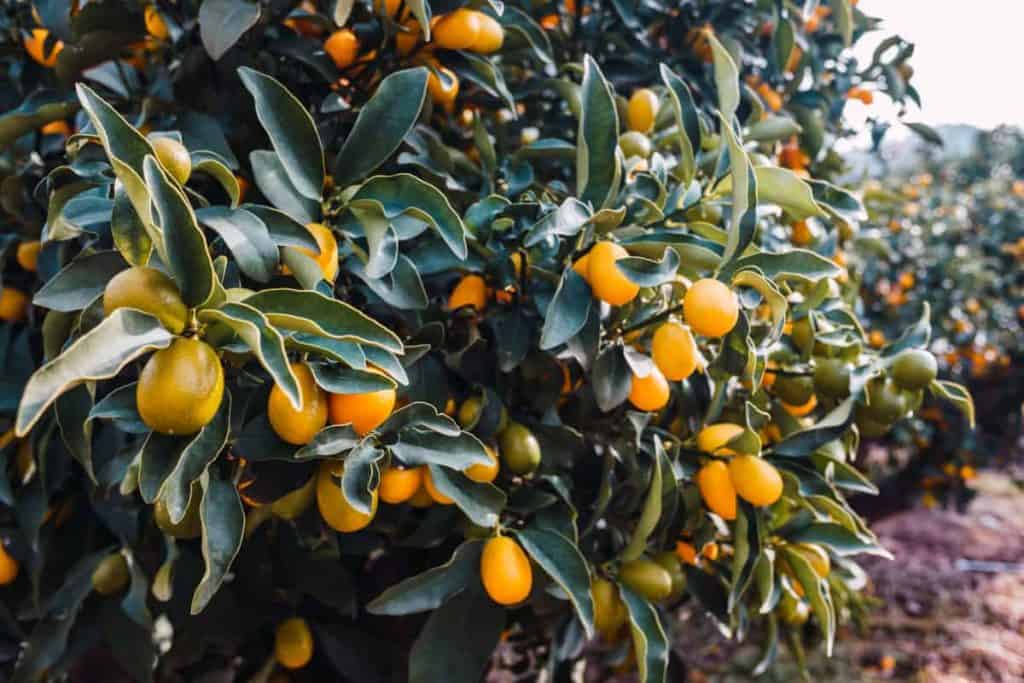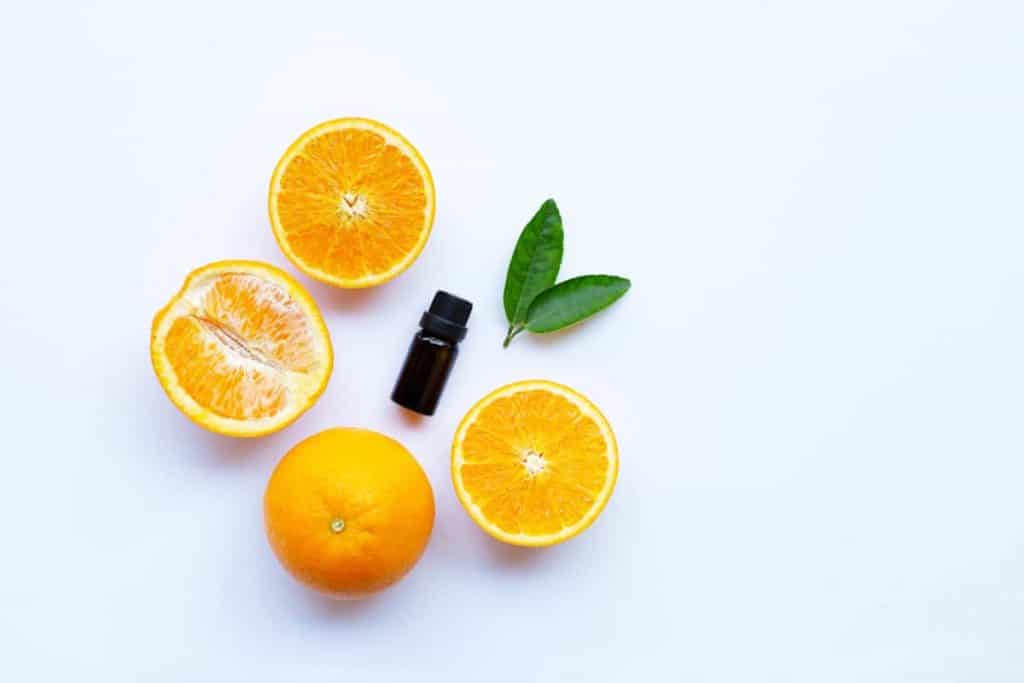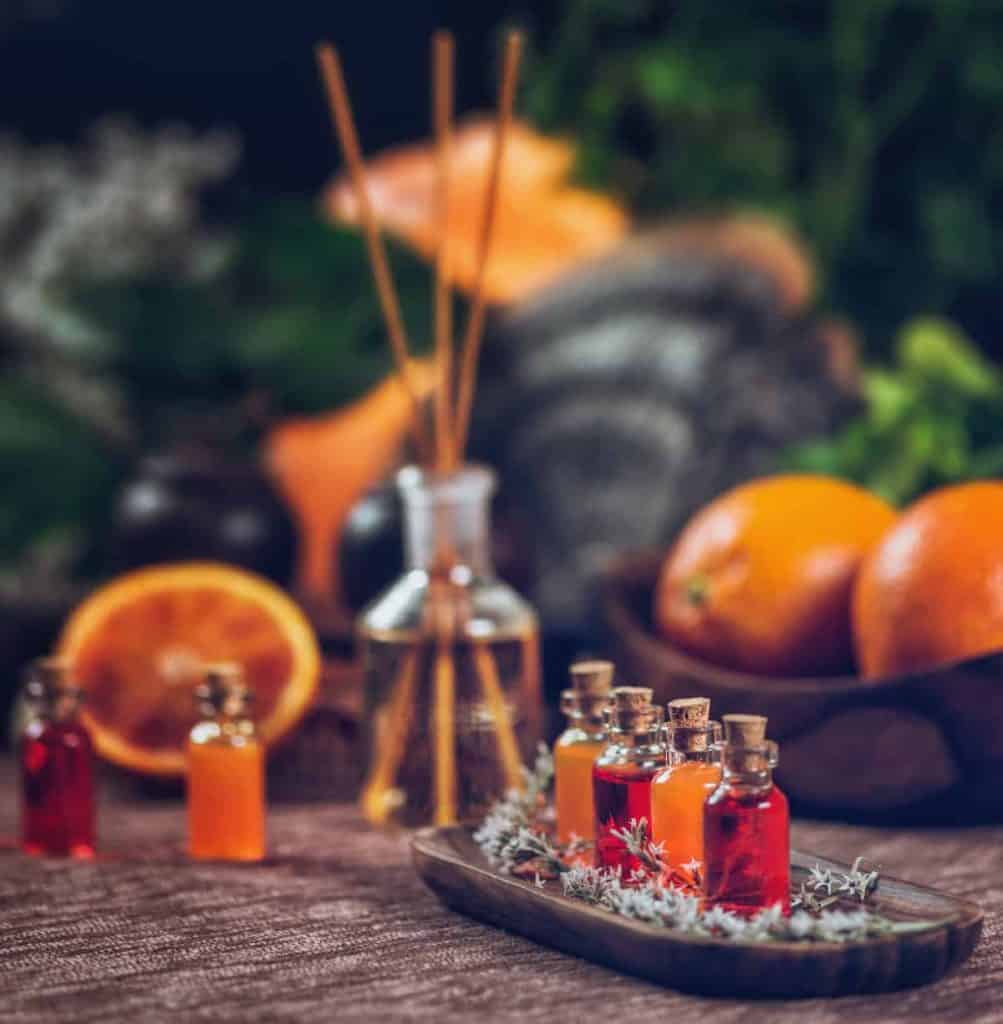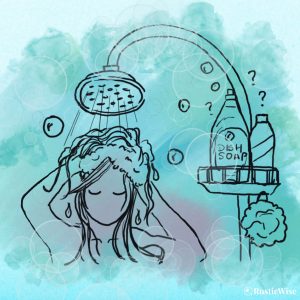10 Fresh Orange Essential Oil Uses and 5 Healing Benefits

While we eat or juice the fruit, the orange peel (or rind) is where orange essential oil derives from. If you’re a fan of citrus fragrances, you’ll love the warming and uplifting properties of orange. Besides its appealing aroma, there are many orange essential oil uses and benefits from its antibacterial and antifungal properties, to its ability to soothe stress.
Unlike some types of EOs that come from endangered trees such as sandalwood, orange trees are plentiful. This is good news if you love orange EO—it’s an affordable, beneficial, and versatile essential oil.
We’ll go over the different types of orange essential oils (yes, there is more than one variety), along with safety and potential phototoxicity. We’ve also made a table that lists good fragrance notes to pair with orange. And of course, we’ll share a roundup of benefits and how you can put that bottle of EO to good use!
Types of orange essential oils
While you might think an orange is an orange, it’s important to note there are different types of orange essential oils. Some derive from a different plant, or from another plant part.
When you hear the term “orange peel oil” or simply “orange essential oil,” most people are actually referring to sweet orange (Citrus sinensis). The aptly named sweet orange tree is an evergreen which produces a sweet fruit. This is the most commonly used orange EO for skincare and beauty products.
Imagine biting into a ripe, juicy and sweet orange, and this is the embodiment of the sweet orange fragrance too.
Don’t confuse this with bitter orange or sour orange (Citrus aurantium), so-called because of its distinctly mild sour and bitter flavor profile. While these two trees look similar, the leaves of the Citrus aurantium look broader and more heart-shaped.
While still fresh and citrus-y, the scent of bitter orange also has slightly “bitter” undertones similar to grapefruit.¹
To keep things interesting, there are also two other EOs that come from the Citrus aurantium tree: ²
- Neroli essential oil derives from the blossoms
- Petitgrain essential oil derives from the twigs and leaves
Sometimes you’ll also see some bottles labelled as wild orange. This is often a blend of various types of orange oils.
Let’s take a closer look at sweet orange vs. bitter orange.
| Sweet Orange EO | Bitter Orange EO | |
|---|---|---|
| Botanical name: | Citrus sinensis | Citrus aurantium |
| Fragrance notes: | Mid-note with medium aroma. Smells like freshly squeezed sweet oranges. | Top note with medium aroma. Smells like oranges with a hint of “bitterness” like that of grapefruit. |
| Blends well with: | Other citrus notes like bergamot and lemon. Try it with earthier notes such as clary sage, or spicier notes like cinnamon bark, clove bud, myrrh, nutmeg, or sandalwood. | Other citrus notes like bergamot and lemon. Lavender pairs well with the bitter notes. Try it with earthier notes such as clary sage, or spicier notes like cinnamon bark, clove bud, myrrh, nutmeg, or sandalwood. |

Credit: Vector State
Main constituents of orange essential oil
While there are slight differences between sweet and bitter orange EOs, we use them in much the same way and for similar purposes.
This is because they contain very similar active/volatile constituents.³
Sweet orange comprises:
- d-Limonene: 83.9–95.9 percent
- Linalool: 0–5.6 percent
Bitter orange contains:
- d-Limonene: 89.7–94.7 percent
- Linalool: 0.1–2.0 percent
Safety notes on orange essential oil uses
Many citrus EOs have phototoxic properties which make your skin more sensitive to sun exposure. While it’s easy to lump all citrus EOs, including orange, into this category, it’s not so simple.
The method in which EOs are extracted appears to play a role in their level of phototoxicity. Oils which are cold pressed (or expressed) often contain higher levels of phototoxic components than their counterparts that are steam distilled.⁴
Keep in mind that some citrus oils like lime or bergamot are very phototoxic, while lemon is mildly so. If you’re making your own essential oil blend by combining orange EOs with other citrus scents, you may increase the phototoxic levels.
Here’s a list of non-phototoxic citrus EOs (or those with low risk):
- Sweet orange (Citrus sinensis) EO
- Mandarin or tangerine (Citrus reticulata) EO
- Neroli, orange blossom, (Citrus x aurantium) EO
- Petitgrain, orange leaf, (Citrus x aurantium) EO
The following are phototoxic citrus EOs (high risk):
- Expressed bitter orange (Citrus x aurantium) EO
- Mandarin leaf (Citrus reticulata) EO
The takeaway: Sweet orange EO is non-phototoxic, while bitter orange is phototoxic.
How to protect yourself from phototoxic essential oils
- When using phototoxic EOs, try to use them for aromatherapy, and avoid putting phototoxic EOs topically onto skin. If you are using it topically, you may decide to rinse it off. Phototoxic EOs added to products like soap or shampoo that are rinsed off are safe.
- Protect yourself from sun exposure (natural light or artificial light from tanning beds) by waiting at least 24 hours after topical application of phototoxic EOs (staying indoors, covering up, etc.).
- And with all EOs, ensure you dilute it to a safe level (typically between 3 to 5 percent) with a skin-safe carrier oil, such as jojoba oil, coconut oil, or sweet almond oil.
- Check with your doctor if you’re pregnant, breastfeeding, or taking certain medications before using EOs.
- Remember that young children should use a smaller amount of EO than adults.

5 orange essential oil benefits for skin and body
The humble orange is a source of many skin and body nourishing constituents. Here are just a few health benefits.
1. May reduce anxiety and stress
Sweet orange oil is considered an anxiolytic, which means it reduces symptoms of anxiety (which includes feelings of distress or fear), and muscle tightness in the body that accompanies such feelings.
A 2013 study examined neurochemical changes in mice after treatment using Citrus aurantium EO. The results show that bitter orange shows anxiolytic-like effects involving 5-HT1A-receptors. This shows promising use of this EO as an alternative treatment.⁵
2. Antibacterial and antifungal properties
Orange EO packs a punch when it comes to banishing bacteria and fungi.
When used topically, orange EO can treat a variety of fungal infections, including athlete’s foot, ringworm, and jock itch.
A 1996 study examined 10 different EOs (including orange) and found that orange was effective against all 22 bacterial strains tested, and 12 types of fungi were also inhibited.⁶
3. May help with acne
With its known antibacterial properties, it comes as no surprise then that orange EO may help treat acne.
A 2012 study prepared a variety of gel formulations to treat acne and examined their antimicrobial properties against bacterial strains that occur in the presence of acne. They compared traditional medicated acne treatments with natural treatments using both sweet orange EO and sweet basil EO.⁷
The results show all patients showed improvements of skin lesions (between 43 and 75 percent clearance).⁷
4. May relieve pain
Orange oil has antispasmodic properties which help with a range of physical aches and pains. Physical pain, whether mild indigestion, muscle aches or more severe cramps women experience during labor, may be alleviated with orange oil.
Traditionally, this citrus EO was used topically to help with indigestion, but its benefits may extend to other bodily pains, too.
One 2008 study examined the use of sweet orange and ginger EOs as a massage oil. The treatment was applied to the elderly patients who had moderate-to-severe knee pain.⁸
After several weeks, patients who received treatment using the EOs experienced reduced pain and less stiffness. However, any pain relief was short-lived and stopped shortly after treatment.
5. May induce a better night’s rest
While we often promote lavender EO for its soothing properties, sweet orange peel oil also has slumber inducing properties.
Bitter orange oil and its sedative properties were examined in a 2002 study on mice. It found that orange peel oil may show promise as a treatment for insomnia.⁹

Credit: Vector State
10 orange essential oil uses
Now that we’ve read up on the various benefits of this powerful citrus oil, let’s see how we can put it to good use at home.
Tip: A good rule of thumb when using a citrus EO, is to dilute it before applying topically. Use 4 drops of orange EO per ounce (30 milliliters) of a skin-safe carrier oil.
1. Aromatherapy
Merely inhaling orange EO may calm the body’s nervous system. If you have an aromatherapy diffuser, an easy way is to add a few drops to it and enjoy the uplifting citrus aroma.
You can make this part of your evening routine if you want to soothe the nerves and promote a more restful night’s sleep.
If you don’t have a diffuser, you can still use the “dry infusion” method by adding a few drops of oil onto a cotton ball and keeping it nearby you on a desk or tabletop.
2. Skin + acne treatment
Wondering how to use sweet orange oil for your face? Use a diluted amount of orange EO with a coconut carrier oil. Apply to problem areas with a cotton ball.
3. Skin cream
Get the nourishing benefits of coconut oil and orange together in one easy and natural skin treatment.
Add 10 to 15 drops of wild orange to roughly 1/2 cup of coconut oil. Massage all over the body for a soothing and nourishing moisturizer.
4. Massage oil
Sore muscles or achy knees? Apply a few drops of orange EO diluted with your favorite carrier oil directly to the source of pain. A few good choices include jojoba oil, olive oil, sweet almond oil, or coconut oil.
5. Soothe indigestion
If your stomach is causing you grief, try applying some orange EO directly to the area of pain.
Dilute a few drops of orange EO into a carrier oil and apply topically to your abdomen.
6. Get rid of itching
Skin irritation may be caused by a variety of fungal infections such as athelete’s foot.
Add a few drops to a carrier oil and apply to the problem area.
7. Add it to homemade soap
Doesn’t orange soap sound lovely? Depending on your soap recipe, you can try adding about 0.5 ounces of orange essential oil per pound of soap.
8. Air freshner
Make your own DIY room spray by adding roughly 10 drops per every ounce (30 milliliters) of water. Shake well before using to incorporate the oil with the water.
9. Natural all-purpose cleaner
Take advantage of orange oil’s natural antibacterial properties to make an eco-friendly all-purpose household cleaner using Castile liquid soap.
You’ll need:
- Spray bottle
- 6 cups of water
- ¼ cup of liquid Castile soap
- 5-10 drops of sweet orange oil
Combine all ingredients and mix well. Shake well before each use.
10. Soothing citrus bath
It’s important to note that essential oils do NOT mix well with water. If you simply place a few drops directly into bath water, it may irritate skin! That’s why a dispersant such as milk must be used before adding to water.
Add a few drops of EO together with a dispersant (2–4 tablespoons) such as creamy milk or goat’s milk before adding to water.¹⁰
👉Find more wellbeing topics on nourishing your body and soul with natural food, herbs, plants, and household products.
New to making soap? 🧼❓
👉We have a fantastic overview on the whole soapmaking process here: read our Timeless Guide To Soapmaking.
If you would like to see our soapmaking posts organized by topic type, see our Soapmaking Collection.

References
- New Directions Aromatics, Orange Orange Essential Oil (Sweet), https://www.newdirectionsaromatics.com/products/essential-oils/orange-essential-oil-sweet.html. Accessed March 2022.
- Tisserand Institute, Bitter orange: same plant, three different oils, https://tisserandinstitute.org/learn-more/bitter-orange-same-plant-three-different-oils/. Accessed March 2022.
- Dosoky, N. S., & Setzer, W. N. (2018). Biological Activities and Safety of Citrus spp. Essential Oils. International journal of molecular sciences, 19(7), 1966. https://doi.org/10.3390/ijms19071966
- Siegmund-Roach, Sherilyn (11 July 2016). “The Truth About Phototoxic Essential Oils & How To Use Them Safely,” The Herbal Academy. Accessed March 2022.
- Costa, C. A., Cury, T. C., Cassettari, B. O., Takahira, R. K., Flório, J. C., & Costa, M. (2013). Citrus aurantium L. essential oil exhibits anxiolytic-like activity mediated by 5-HT(1A)-receptors and reduces cholesterol after repeated oral treatment. BMC complementary and alternative medicine, 13, 42. https://doi.org/10.1186/1472-6882-13-42
- Pattnaik, S., Subramanyam, V. R., & Kole, C. (1996). Antibacterial and antifungal activity of ten essential oils in vitro. Microbios, 86(349), 237–246.
- Matiz, G., Osorio, M. R., Camacho, F., Atencia, M., & Herazo, J. (2012). Effectiveness of antimicrobial formulations for acne based on orange (Citrus sinensis) and sweet basil (Ocimum basilicum L) essential oils. Biomedica : revista del Instituto Nacional de Salud, 32(1), 125–133. https://doi.org/10.1590/S0120-41572012000100014
- Yip, Y. B., & Tam, A. C. (2008). An experimental study on the effectiveness of massage with aromatic ginger and orange essential oil for moderate-to-severe knee pain among the elderly in Hong Kong. Complementary therapies in medicine, 16(3), 131–138. https://doi.org/10.1016/j.ctim.2007.12.003
- Carvalho-Freitas, M. I., & Costa, M. (2002). Anxiolytic and sedative effects of extracts and essential oil from Citrus aurantium L. Biological & pharmaceutical bulletin, 25(12), 1629–1633. https://doi.org/10.1248/bpb.25.1629
- University of Minnesota, How Do I Choose and Use Essential Oils?, https://www.takingcharge.csh.umn.edu/how-do-i-choose-and-use-essential-oils. Accessed March 2022.

Author: Theresa Tesolin
Theresa is co-founder of RusticWise. She helps people unleash their inner DIY spirit by encouraging them to get dirty and make or grow something from scratch.









